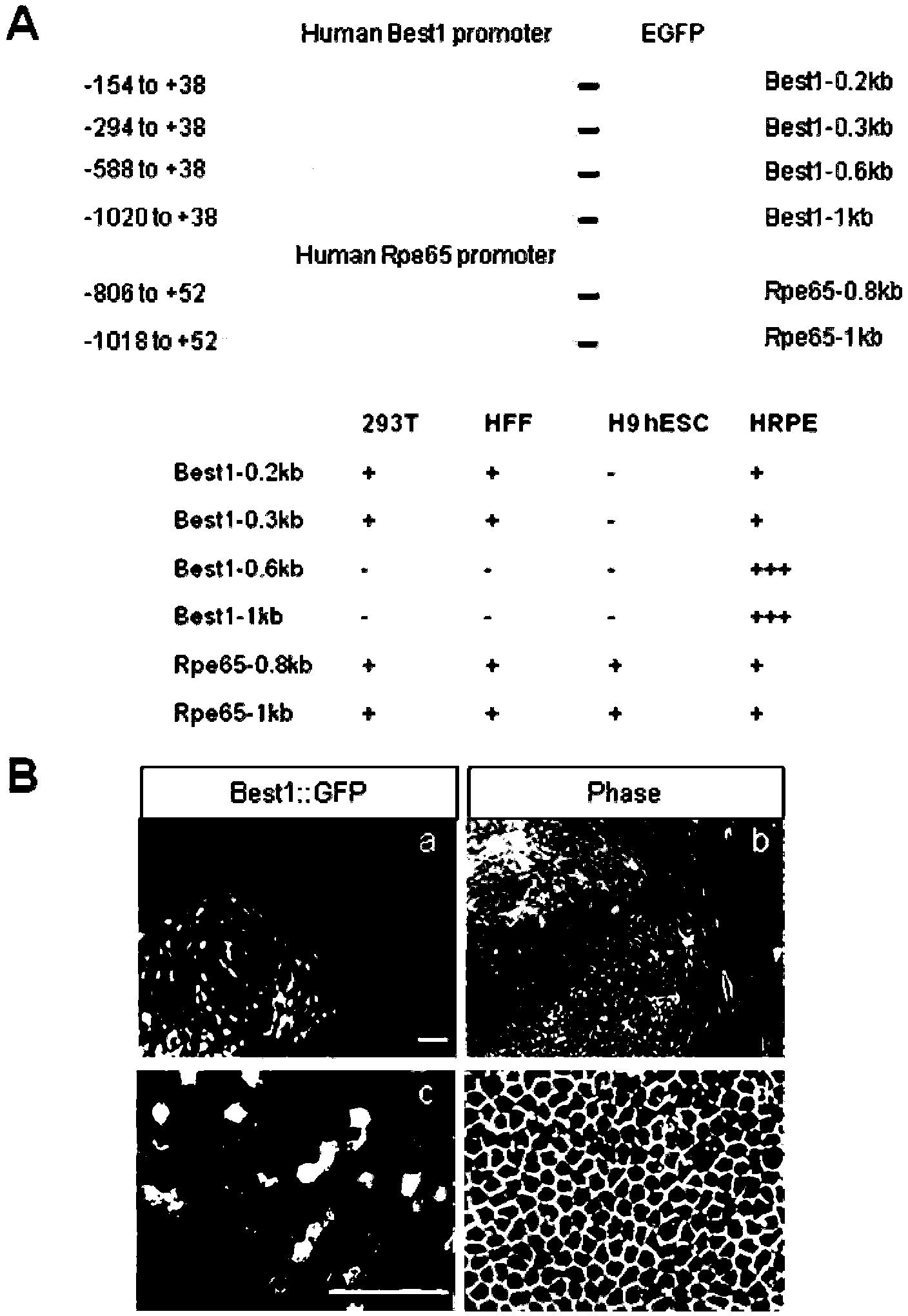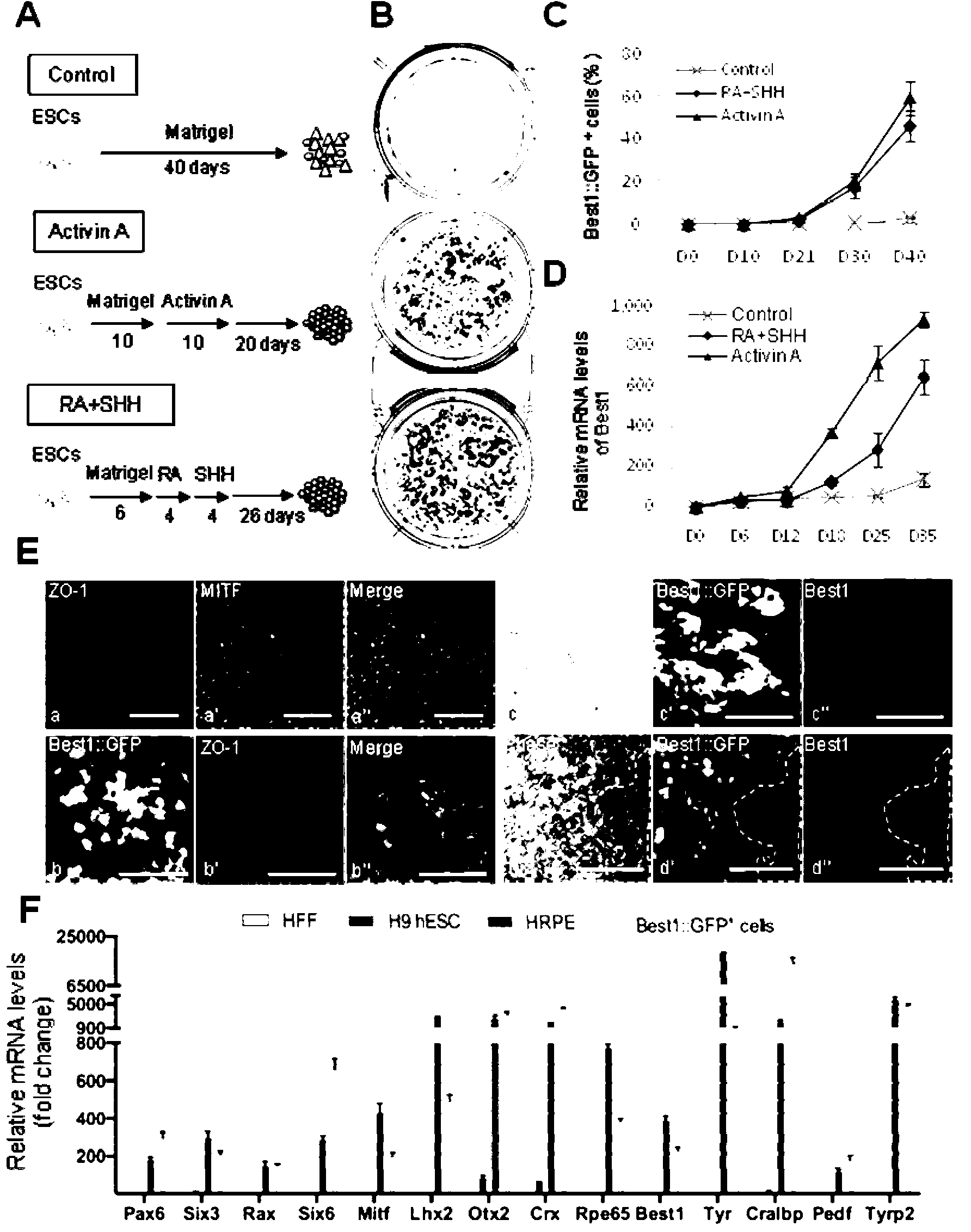Method for transdifferentiation of human fibroblast to retinal pigment epithelium
A retinal pigment and fibroblast technology, applied to cells modified by introducing foreign genetic material, using vectors to introduce foreign genetic material, recombinant DNA technology, etc., can solve problems such as no reports
- Summary
- Abstract
- Description
- Claims
- Application Information
AI Technical Summary
Problems solved by technology
Method used
Image
Examples
Embodiment 1
[0087] 1. Establish a reporter gene system specifically expressed in human retinal pigment epithelial cells.
[0088] Since it has been reported that the promoters of the human Bestrophin1 (Best1) gene and the Rpe65 gene can specifically drive the high expression of the reporter gene in the retinal pigment epithelial cells (RPE) of transgenic mice, so we first put different sizes of The promoter fragments of the human Bestrophin1 (Best1) gene and the Rpe65 gene were cloned into the upstream site of the green fluorescent protein gene (gfp) in the lentiviral genome vector pGreenZeo (U.S. System Biosciences, article number: #SR500VA / PA) (such as figure 2-A), including 4 Best1 gene promoters (0.2kb, 0.3kb, 0.6kb and 1kb in length) and 2 Rpe65 gene promoters (0.8kb and 1kb in length) (such as figure 2 -A and shown in Table 1), then use the lentiviral vector packaging plasmids pMDLg / pRRE, pCMV-VSVG and pRSV-REV (all purchased from Addgene, USA, item numbers: 12251, 35616 and 12253...
Embodiment 2
[0093] Example 2. Transdifferentiation of human fibroblasts to retinal pigment epithelial cells.
[0094] We use the PCR method to obtain six kinds of transcriptional regulators related to retinal development and RPE differentiation (including Rax (NM_013435.2, the sequence is shown in SEQ ID NO.3), Crx (NM_000554.2, the sequence is shown in SEQ ID NO.4 shown), Pax6 (NM_000280.2, sequence shown in SEQ ID NO.5), MitfA (NM_198159.2, sequence shown in SEQ ID NO.6), Otx2 (NM_021728.2, sequence shown in SEQ ID NO. 7) and Nrl (NM_006177.2, the sequence is shown in SEQ ID NO.8)) (such as Figure 4 -A) and the complete coding sequence of two transcription regulators (comprising cMyc (sequence shown in SEQ ID NO.9) and Klf4 (sequence shown in SEQ ID NO.10)) highly expressed in mature RPE cells , and using conventional molecular biology methods (refer to the third edition of "Molecular Cloning", Sambrook, Science Press, 2008) to clone it into the pMX-gateway vector (purchased from Addg...
Embodiment 3
[0097] Example 3. Identification of transdifferentiated cells.
[0098] On the 21st day after using the virus mixture to infect the HFF cells, the BEST1::GFP positive cell clones that were able to emit green fluorescence after being irradiated with blue light were selected under a fluorescent microscope, and inoculated into cells pre-treated with 0.5% qualified-Matrigel (purchased from the U.S. In the 24-well plates treated by BD Biosciences, Cat. No.: 354277), the cells were divided into two experimental groups. First, add 1) Activin A (final concentration 100 nM, R&D System, Cat. No.: 338-AC), or 2) The N2 / B27 medium of RA (retinoic acid, American Sigma Company, article number: R2625) and SHH (working concentration 25nM, American Sigma Company, article number: SRP3156) was continuously cultivated at 37 degrees Celsius and 5% carbon dioxide, and every two Change the medium every day to promote its further maturation (such as Image 6 -B shown). After culturing for 10 days, ...
PUM
 Login to View More
Login to View More Abstract
Description
Claims
Application Information
 Login to View More
Login to View More - R&D
- Intellectual Property
- Life Sciences
- Materials
- Tech Scout
- Unparalleled Data Quality
- Higher Quality Content
- 60% Fewer Hallucinations
Browse by: Latest US Patents, China's latest patents, Technical Efficacy Thesaurus, Application Domain, Technology Topic, Popular Technical Reports.
© 2025 PatSnap. All rights reserved.Legal|Privacy policy|Modern Slavery Act Transparency Statement|Sitemap|About US| Contact US: help@patsnap.com



